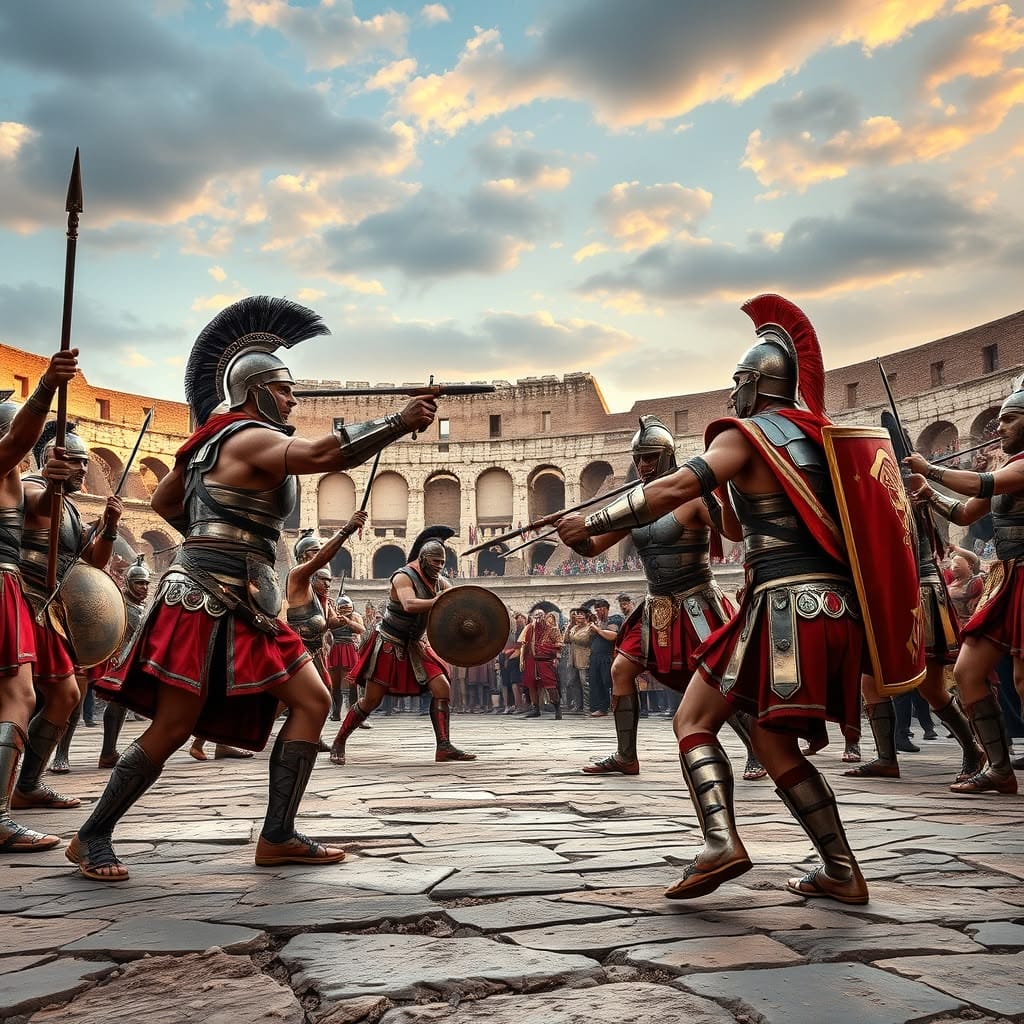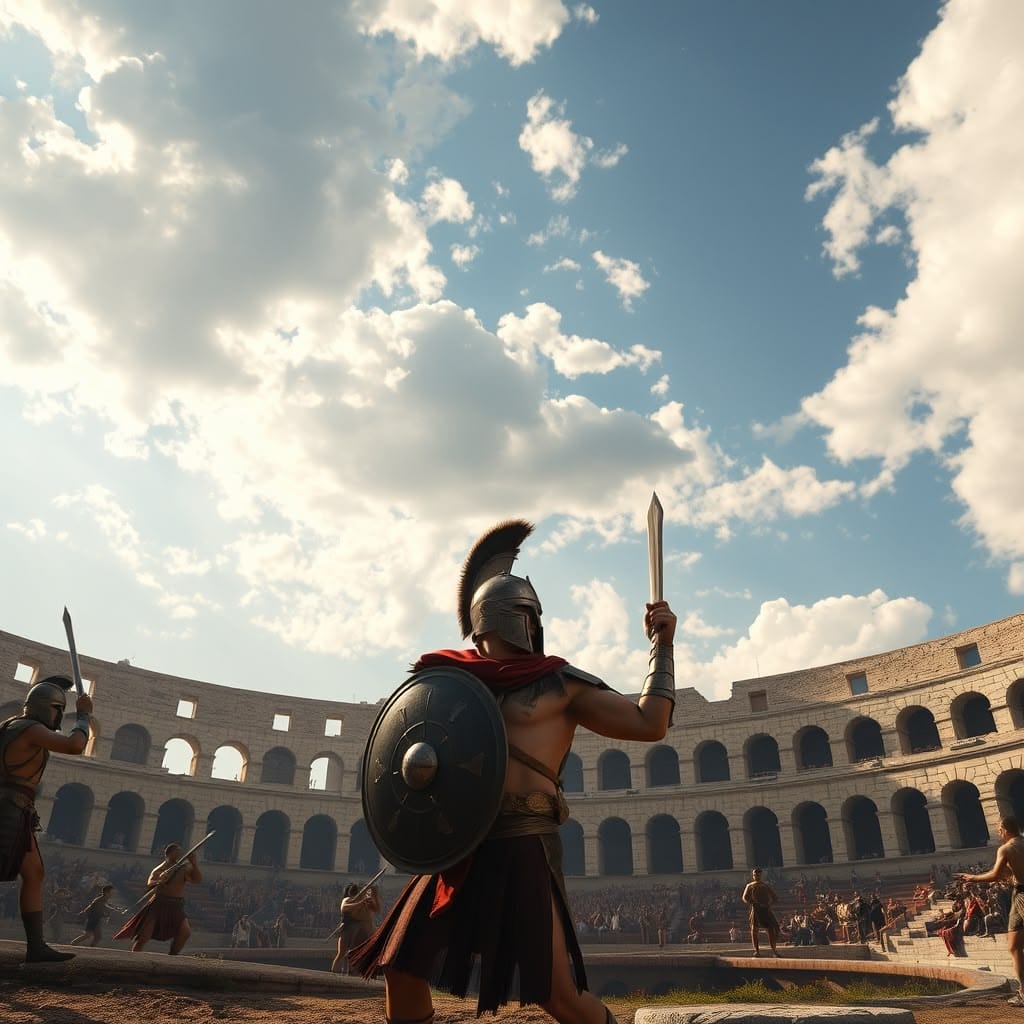Gladiators have a rich history that began with Etruscan funerary customs, where they fought to honor the dead. Different types of gladiators, like the Samnite and Retiarius, showcased various fighting styles and weaponry. The games became massive events in Rome, especially under emperors such as Julius Caesar. Despite often being slaves or prisoners, some gladiators gained fame and admiration from the public. The crowd played a vital role in deciding their fate during battles. Interestingly, female gladiators also participated in these games, challenging norms of the time. Eventually, changing values led to the decline of these brutal contests but left a lasting mark on culture.

Origins of Gladiators in Ancient Rome
Gladiators trace their roots back to Etruscan funerary practices, where combat was seen as a way to honor the dead. During funerals, warriors would engage in battle to serve as armed attendants for the deceased in the afterlife. This tradition highlighted a belief in the importance of valor and strength even beyond death. As these rituals evolved, they transitioned from private events to public spectacles. By the time of the Roman Empire, gladiatorial combat had become a prominent form of entertainment, attracting large crowds and becoming an integral part of Roman culture. The spectacle of gladiators fighting for survival captivated audiences and reflected the societal values of bravery and sacrifice.
Different Types of Gladiators
Gladiators in ancient Rome were not a monolithic group; they were categorized into various types, each with unique fighting styles and equipment. The Samnite was among the most recognized, equipped with a large rectangular shield and a short sword called a gladius, making them formidable opponents in close combat. In contrast, the Thracian used a smaller shield and a curved sword, allowing for quick and agile movements, which made them effective in evasion and attack. Another distinct type was the Retiarius, who fought with a net and a trident. This gladiator specialized in entangling opponents and striking from a distance, showcasing a different strategy compared to the heavily armored fighters.
The diversity in gladiatorial types not only made the games more exciting but also reflected the varied combat techniques of the time. Events often featured these different classes in combination, creating thrilling matchups that captivated audiences. The unique weapons and styles contributed to the gladiators’ identities, making them memorable figures in the arena. For example, the sight of a Retiarius trying to ensnare a heavily armored Secutor—a gladiator known for his full body armor and sword—was particularly dramatic, highlighting the clash of tactics between the light and heavy fighters.
| Type | Weapons | Fighting Style |
|---|---|---|
| Samnite | Large shield, short sword | Heavy infantry style combat |
| Thracian | Curved sword, small shield | Aggressive and quick strikes |
| Retiarius | Net, trident | Fast and strategic, focused on entrapment |
The Popularity of Gladiatorial Games
Gladiatorial games were a cornerstone of Roman entertainment, evolving from small local exhibitions to massive events attracting thousands of spectators. The games were not just about combat; they were a way for emperors like Julius Caesar and Trajan to showcase their power and gain popularity among the citizens. These spectacles often featured up to 5,000 pairs of gladiators fighting at once, turning the arena into a place of thrilling spectacle and bloodshed. The excitement of the crowd played a pivotal role, as their reactions could determine the fate of the defeated gladiators. A thumbs up or down could mean life or death, making the spectators active participants in the drama unfolding before them. This intense engagement fostered a sense of community and shared experience, as Romans from all walks of life gathered to witness the battles. The games also reflected the social hierarchy of Rome, where the elite would watch while common citizens cheered for their favorites, creating a profound connection between the gladiators and the audience.

Social Status of Gladiators
Gladiators in Ancient Rome occupied a unique and complex social status. Most were slaves, prisoners of war, or criminals forced into the arena, yet some were free men who chose this dangerous path in search of fame and fortune. These free gladiators could achieve celebrity status, gaining admiration from the public and wealth through victory. Successful fighters were often celebrated like modern-day sports stars, receiving gifts and attention from wealthy patrons. Despite their often grim circumstances, the allure of glory and the chance to rise above their origins motivated many to take up the sword. This duality of being both revered and marginalized highlights the intricate social dynamics of Roman society, where the line between hero and victim was often blurred.
The Role of Spectators in Combat
The spectators of gladiatorial games held immense power over the fate of the fighters. When a gladiator was defeated, it was the crowd’s decision whether he would live or die. This was often conveyed through hand gestures, where a thumbs-up could mean mercy, while a thumbs-down signaled death. The phrase “pollice verso” refers to this tradition, although the exact gestures used are still debated by historians. The audience’s reaction was influenced by their emotions and the performance of the gladiators. A valiant fight could win the crowd’s favor, swaying them to spare a defeated fighter. This connection between the fighters and their audience added a layer of drama to the games, making each bout not just a test of skill but also a spectacle of public opinion.
Training and Gladiator Schools
Gladiators trained in specialized schools known as “ludi,” which were crucial for their preparation. In these schools, they learned various combat techniques and styles specific to their class of gladiator. Training was intense, often resembling military drills, focusing on physical conditioning, weapon handling, and strategic fighting. Gladiators would typically train under the guidance of a lanista, who was responsible for their development. The camaraderie formed among gladiators was significant; they often developed close friendships, akin to a brotherhood, as they faced the same dangers in the arena. This bond was vital for their mental strength, as they relied on each other during both training and actual combat. The rigorous training not only prepared them for the arena but also instilled discipline, making them formidable fighters.
- Gladiator training was rigorous and included various combat techniques.
- Many gladiators started training from a young age, often as slaves or prisoners of war.
- Training schools, known as ‘ludi’, were spread throughout the Roman Empire.
- Each school specialized in different fighting styles and weaponry.
- Gladiators were often coached by experienced instructors called ‘doctores’.
- Physical fitness and endurance were crucial aspects of training.
- Some gladiators trained in groups to simulate battle scenarios.

The Existence of Women Gladiators
While most gladiators were male, there is evidence that women, known as “gladiatrices,” also fought in the arena. Historical records, such as inscriptions and artwork, indicate that female gladiators participated in public games, albeit less frequently than their male counterparts. Some of these women were slaves, while others may have been free, motivated by the chance for fame and fortune. The presence of female fighters challenges the traditional view that gladiatorial combat was solely a male domain. In fact, accounts from ancient writers, such as Juvenal and Suetonius, reference women engaging in gladiatorial contests, showcasing their skills and bravery. One notable example is the Roman Empress, who reportedly organized games featuring female gladiators, further highlighting their participation in this brutal yet popular form of entertainment.
Political Influence of Gladiators
Gladiators held a surprising amount of political influence in ancient Rome. While they were primarily seen as entertainers, their roles extended beyond the arena. For instance, some gladiators were employed as bodyguards for powerful politicians and generals, leveraging their combat skills to protect influential figures. The most notable example is the famous revolt led by Spartacus, a gladiator who became a symbol of resistance against oppression in 73-71 BCE. His uprising captured the attention of the Roman Republic, posing a significant threat to its stability. Additionally, because gladiatorial games were major public spectacles, politicians used them to gain favor with the populace. Hosting grand games with popular gladiators could enhance a politician’s reputation and power, showcasing their generosity and connection to the people.
The Decline of Gladiatorial Games
The decline of gladiatorial games in Ancient Rome can be traced to significant shifts in societal values and the rise of Christianity. As Christianity gained prominence, the moral implications of such brutal spectacles began to be questioned. The games, once celebrated as a display of strength and valor, were increasingly seen as inhumane and contrary to Christian teachings, which emphasized compassion and the sanctity of life. This cultural transformation was marked by the edict of Emperor Constantine I, who officially abolished the games in 325 CE during the First Council of Nicaea. Although the games lingered in some regions for years afterward, the decline was evident as public interest waned and the societal context shifted. By the end of the 4th century, the once-grand arenas that hosted thousands of spectators became relics of a bygone era, signaling the end of an infamous chapter in Roman history.
Cultural Impact of Gladiators
Gladiators have had a profound cultural impact that extends far beyond the confines of the arenas in ancient Rome. Their legacy is evident in modern films, literature, and visual art, where they are often depicted as symbols of strength, bravery, and the struggle for survival. Movies like “Gladiator” and “Spartacus” have popularized their stories, showcasing the dramatic battles and moral dilemmas faced by these fighters. Additionally, gladiators are frequently referenced in various forms of media, highlighting themes of honor and sacrifice. The image of the gladiator continues to evoke fascination, representing the human spirit’s resilience against adversity. This cultural resonance reflects society’s ongoing interest in conflict, heroism, and the complexities of life and death.

Frequently Asked Questions
1. What were gladiators in ancient Rome?
Gladiators were fighters in ancient Rome who battled each other or animals in arenas, like the famous Colosseum, often for public entertainment.
2. How did one become a gladiator?
Many gladiators were slaves or prisoners of war who were forced to fight, but some volunteered for fame, glory, or to pay off debts.
3. Did all gladiators fight to the death?
Not all gladiator fights ended in death. Many times, a defeated fighter could be spared if they fought well or the crowd wanted them to live.
4. What types of weapons did gladiators use?
Gladiators used various weapons, including swords, tridents, nets, and shields, depending on their fighting style and category.
5. What role did the crowd play in gladiator games?
The crowd played a huge role in gladiator games. Their cheers or boos could decide whether a gladiator lived or died after a fight.
TL;DR Gladiators in Ancient Rome originated from Etruscan funerary rites and evolved into popular spectacles featuring various types such as Samnites and Retiarii. They were mainly slaves or criminals but could gain fame and admiration. Spectators played a vital role in the outcome of fights, while gladiators trained rigorously in special schools. There were even female gladiators, challenging gender norms. The games declined with the rise of Christianity, and despite their end, gladiators remain influential in modern culture, symbolizing strength and bravery.

